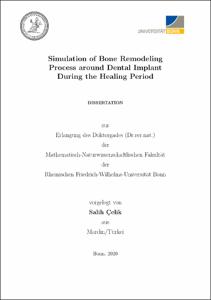Simulation of Bone Remodeling Process around Dental Implant During the Healing Period

Simulation of Bone Remodeling Process around Dental Implant During the Healing Period

| dc.contributor.advisor | Bourauel, Christoph Peter | |
| dc.contributor.author | Çelik, Salih | |
| dc.date.accessioned | 2021-07-05T10:10:14Z | |
| dc.date.available | 2021-07-05T10:10:14Z | |
| dc.date.issued | 05.07.2021 | |
| dc.identifier.uri | https://hdl.handle.net/20.500.11811/9197 | |
| dc.description.abstract | This interdisciplinary thesis deals with the numerical investigation of bone remodeling around dental implants during the healing period with regard to biomechanical aspects. The aim of the study was to develop algorithms for the simulation of the tissue behavior during this very critical phase of implant healing, including osseointegration processes at the implant surface as a time-dependent function in response to local mechanical stimulus.
Initially, two dimensional (2D) and three dimensional (3D) Finite Element (FE) simulations were performed to calculate the loading of the bone bed around dental implants. The remodeling theory presented by Li et al. was used in our remodeling simulations. Three different layers with three different thicknesses were added around the implant in the models to simulate the osseointegration phases. Phase 1: Layers of 0.1, 0.2, and 0.3 mm, respectively, of connective tissue (CT), surrounded the implant. Phase 2: Layers of 0.1, 0.2, and 0.3 mm CT, soft callus (SOC), and intermediate soft callus (MSC) surrounded the implant. Phase 3: Layers of 0.1, 0.2, and 0.3 mm SOC, MSC, and stiff callus (SC) surrounded the implant. Different boundary conditions and material properties were applied to the models considering different bone remodeling parameters. Various forces (100-300 N) were applied on the implants at 20° and 0° from their long axis. The model was subjected to a compression and tension pressure with 0.5-10.0 MPa on the lingual and the labial sides to simulate muscle forces. Additionally, implant stability and the effect of the bending forces were investigated in this thesis. By comparing the applied force on the implant of 100 and 300 N, the density of bone reached the maximum value on the cortical bone and the outside of the spongious bone at 300 N. Comparing the muscle forces on the models, the bone formation was obtained in the spongious bone and around the implant at 1.5-4.0 MPa. Osseointegration was observed with a layer of 0.1 mm thickness in the 2D model. With a layer of 0.3 mm simulation resulted in bone resorption. The results of these simulations compared to the studies of several other authors. Subsequently, so-called bone remodeling theories were used to simulate the long-term behavior of the bone bed around the cyclically loaded implant. A stable region for all remodeling parameters could be determined, such that bone density resulted in an equilibrium state with a soft tissue layer of 0.1 mm, which is in accordance with clinical findings. These studies will help to predict the osseointegration of dental implants and will help to assess the clinical reliability, especially of immediately loaded implants, and, if necessary, to optimize their design and their prosthetic superstructure. This could offer a future way into a patient dependent treatment planning and the prediction of long-term stability of dental implants. | en |
| dc.language.iso | eng | |
| dc.rights | In Copyright | |
| dc.rights.uri | http://rightsstatements.org/vocab/InC/1.0/ | |
| dc.subject | Bone Remodeling | |
| dc.subject | Zahnimplantat | |
| dc.subject | Osseointegration | |
| dc.subject | Finite-Elemente-Methoden | |
| dc.subject | Knochendichte | |
| dc.subject | Dental Implant | |
| dc.subject | Finite Element Methods | |
| dc.subject | Bone Density | |
| dc.subject.ddc | 530 Physik | |
| dc.subject.ddc | 570 Biowissenschaften, Biologie | |
| dc.subject.ddc | 610 Medizin, Gesundheit | |
| dc.subject.ddc | 620 Ingenieurwissenschaften und Maschinenbau | |
| dc.title | Simulation of Bone Remodeling Process around Dental Implant During the Healing Period | |
| dc.type | Dissertation oder Habilitation | |
| dc.publisher.name | Universitäts- und Landesbibliothek Bonn | |
| dc.publisher.location | Bonn | |
| dc.rights.accessRights | openAccess | |
| dc.identifier.urn | https://nbn-resolving.org/urn:nbn:de:hbz:5-61729 | |
| ulbbn.pubtype | Erstveröffentlichung | |
| ulbbnediss.affiliation.name | Rheinische Friedrich-Wilhelms-Universität Bonn | |
| ulbbnediss.affiliation.location | Bonn | |
| ulbbnediss.thesis.level | Dissertation | |
| ulbbnediss.dissID | 6172 | |
| ulbbnediss.date.accepted | 26.04.2021 | |
| ulbbnediss.institute | Mathematisch-Naturwissenschaftliche Fakultät : Fachgruppe Physik/Astronomie / Institut für angewandte Physik (IAP) | |
| ulbbnediss.fakultaet | Mathematisch-Naturwissenschaftliche Fakultät | |
| dc.contributor.coReferee | Urbach, Carsten |
Dateien zu dieser Ressource
Das Dokument erscheint in:
-
E-Dissertationen (4337)




